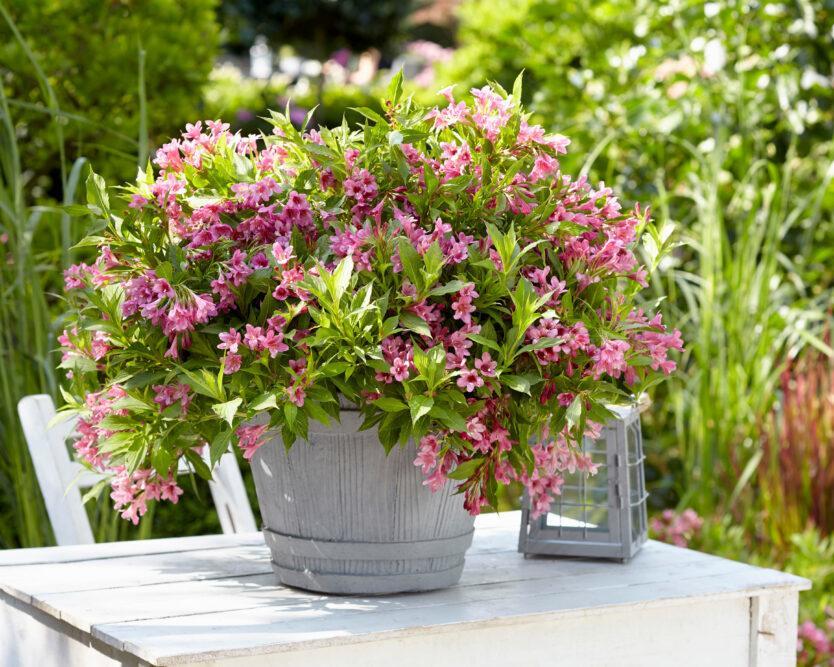Article by Pattie Barron
Welcome to a sensational show house with interiors that look a million dollars – but cost far less. This is Nightingale House, a three-bedroom home at the Grade II-listed former Cambridge Military Hospital in Aldershot, Hampshire, newly developed by Weston Homes and reborn as Gun Hill Park, with 140 apartments and houses in landscaped grounds.
 Nightingale House is a masterclass for new homeowners in what can be achieved on a strict budget. It looks incredible – but in large part it features preloved furniture and fittings bought on eBay, with stand-out style achieved using smaller touches of luxurious yet accessibly priced fabrics and wallpaper supplied by partner in the project, GP & J Baker, of the world-renowned Design Centre at Chelsea Harbour. Robin Daines, project design manager for GP & J Baker, took up the challenge.
Nightingale House is a masterclass for new homeowners in what can be achieved on a strict budget. It looks incredible – but in large part it features preloved furniture and fittings bought on eBay, with stand-out style achieved using smaller touches of luxurious yet accessibly priced fabrics and wallpaper supplied by partner in the project, GP & J Baker, of the world-renowned Design Centre at Chelsea Harbour. Robin Daines, project design manager for GP & J Baker, took up the challenge.
“Many show homes in central London are dressed on a six-figure budget,” points out Suzanne Aplin, marketing director of Weston Homes, “but with Nightingale House we wanted a show house deliberately designed on a relatively modest budget, that still looks incredible.”
 That was the brief given to Robin, along with the request to give the house the ambience of a real, lived-in family home – with subtler tricks than littering the rooms with framed portraits of model families.
That was the brief given to Robin, along with the request to give the house the ambience of a real, lived-in family home – with subtler tricks than littering the rooms with framed portraits of model families.
Nightingale House – named after Florence Nightingale, the founder of modern nursing whose influence helped to create Cambridge Military Hospital – has its own entrance, patio and landscaped garden, and was created from part of this stunning architectural gem, built in the late 19th century in grand neoclassical style. Weston Homes well deserves the praise it has received for this challenging conversion into private homes, many of which enjoy grandeur and historic character as part of their interiors. Many, including this show home, retain the original high ceilings and windows, while Nightingale House also has a spectacular sweeping staircase in the entrance hall, which added to the exciting interior design challenge.
MAKE A LITTLE GO A LONG WAY
At over 15ft high, those magnificent ceilings are a decorator’s dream, but Robin avoided the temptation of filling the walls with pictures or giving the tall, elegant windows fussy fabric treatments, allowing the building’s light and airy qualities to shine through. Case in point is the staircase, where one solitary piece draws the eye: a fabulous hand-woven tribal rug, adding texture and warmth to the expansive wall, while at the entrance, a splendid wide, circular, marble-topped table on a steel-spindled base holds a bowl of white orchids. Both these statement pieces perfectly illustrate Robin’s high-on-impact, low-on-cost, design ethos for the house. The rug cost £125 while the table – the most expensive piece of furniture in the house – cost under £300. “The challenge, especially when you have a space this large,” says Robin, “is to make a little go a long way.”

BUY SMART, BUY E-BAY
In fact, Robin’s secret weapon – and a favourite pastime – is trawling online auction platform eBay for special treasures that are preloved and, in some cases, apparently unloved because they are not even out of their boxes. “Buying on eBay, which for me is a safer bet than buying at auction, means that you have many different things coming from different places and different periods, and so you get a feeling that the rooms have evolved over time, rather than buying new things from one place,” he says. “And it’s a sustainable way of shopping, which is important.”
CREATE A FLOW WITH NEUTRALS
He kept to simple backdrops throughout of neutrals – palest clay, vanilla, never stark white – to make a good flow through the rooms. “If you decorate a room with colour, you’re tied to a scheme. Start on a neutral canvas, and you can build layers with colours and textures.” His choice of colours for textiles as well as decorative objects leans towards earthy tones of Africa: rusty oranges, mustard, olive greens with flashes of teal that mesh perfectly with his preferred choice of furniture.
LOOK TO THE CLASSICS
“I’m a huge fan of mid-century furniture, and I’ve used it throughout the house,” Robin says. “I just aspire to the beautiful timbers that were used. They’re proper pieces of furniture that don’t cost a fortune and work with everything: timeless, functional as well as good-looking.”
In the dining area, the extendable dining table was a £200 steal and the handsome sideboard, late 1950s, was £175, both solid teak, both from eBay. In the living room, a pair of elegant lacquer-black consoles on either side of the archway entrance were an eBay triumph: “They’re from West Elm, originally £300 or £400 but I got them for 50 quid. They’re a bit scuffed, but with a bit of black shoe polish you’d never know.”
 LET IN THE LIGHT
LET IN THE LIGHT
Robin’s smart – and thrifty – choices taken from GP & J Baker’s extensive library of textiles, from Thread’s textural ottoman weaves on the sofas to Baker Lifestyle’s plain linens for the three bedrooms’ Roman blinds, are worth noting. His take on trad net curtains for the dining area’s French doors and the living room’s long sash windows is to use Kravet’s openwork textural sheers that let the light in, yet have the body to take tailored pleats at top, suspended from simple bronze rods.
SPLASH THE CASH ON SMALL ITEMS
“Use less expensive fabrics for curtains and upholstery,” advises Robin, “then accent with smaller items of pricier fabrics to elevate or add a pop of colour to a room.”
He saved extravagant splurges for cushions, such as using the exotic Mughal Garden print Shalimar from GP & J Baker’s Caspian Collection for a pair of cushions in the guest bedroom, piping them in gold velvet, and featuring them with two plain cushions of the less expensive velvet. In the same room, a long, teak bench – a giveaway with the £200 dining table – is given star quality with a mattress cushion in Kravet’s  rich kilim weave. The same principle applies to wallcoverings, too: kitting out the small loo in the entrance hall with just two rolls of Mulberry Home’s exquisite Naval Ensigns wallpaper – the vibrant maritime flags a nod to the hospital’s military past – makes the cost affordable and transforms the room into an absolute jewel.
rich kilim weave. The same principle applies to wallcoverings, too: kitting out the small loo in the entrance hall with just two rolls of Mulberry Home’s exquisite Naval Ensigns wallpaper – the vibrant maritime flags a nod to the hospital’s military past – makes the cost affordable and transforms the room into an absolute jewel.
USE FABRICS LIKE A PRO
The point is, it’s not just fabrics that deliver a look of luxury, it’s how you use them. “And keeping everything sharp and tailored gives it a modern edge,” says Robin. Dove grey contrasting fabrics on the living room armchairs are united with overscaled bronze studs, precisely space nailed, giving them an artisan touch. The dining chairs have backs of faux leather – practical, points out Robin, because that’s where you handle them – but when you pull them out, the seats are upholstered in a smart, contrasting, geometric weave. A simple circular side table is upholstered, too: “I had an MDF circle cut for it, covered it with khaki flannel and finished it with a metre of Kravet’s braided leather trim. Much more interesting than having yet another wooden table.”
THINK CREATIVELY
Throughout the house, creative touches personalise the space, turning it into a home: an oversized white papier-mache bowl from Zara, a snip at £15, holds faux succulents as a coffee table centrepiece; sculptural resin candlesticks bought for a song in an Anthropologie sale; antique Chinese tin tea urns on the black console tables in the living room, converted to decorative lampstands.
 Paintings bought on eBay and reframed, mostly abstracts, are displayed not just on walls – mounted on tray frames – but also on easels, including cute tabletop versions, that Robin first paints and waxes to give them a glossy finish. In one bedroom, he’s even framed Victorian artists’ palettes.
Paintings bought on eBay and reframed, mostly abstracts, are displayed not just on walls – mounted on tray frames – but also on easels, including cute tabletop versions, that Robin first paints and waxes to give them a glossy finish. In one bedroom, he’s even framed Victorian artists’ palettes.
Not everything has to be unusual or unique, though. It just has to work with the room. Classic cheap-as-chips white Japanese lanterns that have graced many a bedsit are Robin’s choice of light shades for the bedroom ceilings. “Their simple, organic shapes are perfect; I bought the biggest sizes I could find.”
MIX HIGH-END WITH HIGH STREET
The key to Robin’s accessible style of decorating is simple – mix things up, get creative. He says: “A totally traditional look can date; having everything contemporary can be quite cold. Mixing high-end with high street, treasured pieces with new finds, creates warmth and a cosy atmosphere. That’s what makes a house a home. Getting everything from one place is the easy option – but it’s the dull one.”














